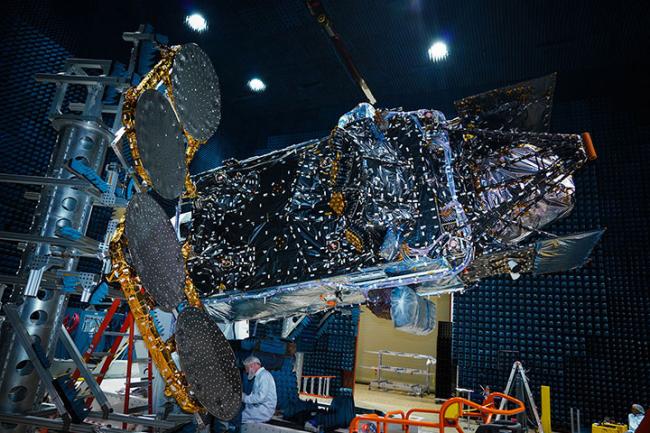On February 27, 2023, the TEMPO instrument and entire spacecraft successfully passed pre-launch testing at Maxar's facility in Palo Alto, California.

Cambridge, MA – Air pollution is an existential threat to millions of Americans with asthma and other health issues. In response to that threat, NASA and the Smithsonian Astrophysical Observatory are innovating to improve observations of air quality in North America.
Tropospheric Emissions: Monitoring of Pollution (TEMPO) is a UV-visible spectrometer that will be hosted on Intelsat 40e, a commercial satellite built by Maxar Technologies. TEMPO's sensors will measure sunlight reflected and scattered back from Earth’s surface and atmosphere, allowing it to "see" a range of air pollutants, including ozone and nitrogen dioxide.
On February 27, 2023, the instrument and the entire spacecraft successfully passed pre-launch testing at Maxar's facility in Palo Alto, California. TEMPO underwent thermal vacuum, dynamics, and end-to-end and capability testing to ensure it will withstand launch conditions and the harsh environment of space. Tests also ensured that commanding, telemetry, and mission data are flowing accurately.
Scheduled to launch in April 2023 from Cape Canaveral aboard a SpaceX Falcon 9 rocket, TEMPO will be the first instrument to observe air pollution hourly during daytime over North America. It will make measurements across an area that extends from Puerto Rico to northern Canada and from the Atlantic Ocean to the Pacific, encompassing the entire continental United States.
TEMPO data will play an important role in scientific studies of phenomena such as rush-hour pollution and the movement of emissions from forest fires and volcanoes. Scientists could eventually apply TEMPO observations to air quality alerts for people in pollution hot spots and those living with health issues.
TEMPO will also form part of a virtual constellation of air pollution monitors that will give global scientists a big-picture view of air quality around the Northern Hemisphere.
Ball Aerospace in Broomfield, Colorado, built the TEMPO instrument. Kelly Chance, a scientist at the Smithsonian Astrophysical Observatory in Cambridge, Massachusetts — part of the Center for Astrophysics | Harvard & Smithsonian — is the principal investigator.
# # #
About the Center for Astrophysics | Harvard & Smithsonian
The Center for Astrophysics | Harvard & Smithsonian is a collaboration between Harvard and the Smithsonian designed to ask—and ultimately answer—humanity's greatest unresolved questions about the nature of the universe. The Center for Astrophysics is headquartered in Cambridge, MA, with research facilities across the U.S. and around the world.
Media Contact:
Nadia Whitehead
Public Affairs Officer
Center for Astrophysics | Harvard & Smithsonian
nadia.whitehead@cfa.harvard.edu
617-721-7371
Related News
NASA Media Call on Upcoming Air Quality Satellite Launch
Media Advisory: New Space Instrument To Deliver Near Real-Time Air Pollution Data
First Rocky Exoplanet Confirmed with NASA's JWST
A Leading Light in Atmospheric Science
New from JWST: An Exoplanet Atmosphere as Never Seen Before
Astronomers Warn of Risk of Misinterpreting JWST Planetary Signals
New Grant Supports Teen Air Quality Studies
Astronomers Detect Carbon Dioxide on Planet for the First Time with JWST
TEMPO Air Pollution Instrument Completes Satellite Integration
Stellar Winds and Evaporating Exoplanet Atmospheres
Projects
AstroAI
AtomDB
GMACS
For Scientists
HITRAN and HITEMP Database
Sensing the Dynamic Universe
SDU Website